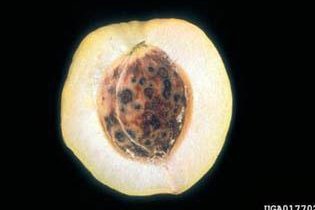1 of 2 | A peach infected with plum pox. Photo provided by the U.S. Department of Agriculture
EVANSVILLE, Ind., Oct. 24 (UPI) -- The United States this week became the only country to eradicate a highly destructive stone fruit disease called the plum pox virus.
The plum pox virus infects trees like plum, almond and peach. Infected trees produce far less fruit than healthy ones, and the fruit they do produce can be deformed or discolored.
The virus originated in Europe in the early 1900s and still is widespread there, costing the stone fruit industries hundreds of millions of dollars a year, according to Cornell University.
It was discovered in the United States in 1999, when a farmer in Pennsylvania noticed something odd happening to his fruit.
"I first spotted a strange ring pattern on some of my peaches and wasn't sure what could have caused it," Jim Lerew, the owner of a Pennsylvania orchard with the first known plum pox case in the country, told the Penn State Extension.
"After I found it several more times on my peach crop, I took some samples to a number of different fruit research institutions to determine the cause ... which admittedly stumped them for a while. No one had even considered that it could be a disease that originated in Europe."
Once they figured it out, researchers began to test orchards and soon learned that the disease had spread across Pennsylvania. The U.S. Department of Agriculture, with the help of the state department of agriculture and the Penn State Extension, went to work to contain it.
The battle went on for a decade, during which time the state destroyed some 1,675 acres of commercial stone fruit trees -- 20 percent of Pennsylvania's stone fruit industry. Farmers were paid $32 million in compensation, according to Penn State Extension.
Then, in 2009, the Pennsylvania Department of Agriculture announced that the state had no new positive tests in three years -- that plum pox was eradicated.
But as Pennsylvania celebrated, the battle was just beginning elsewhere. In 2006, the virus was found in New York state and Michigan.
"Since the disease was first detected in Pennsylvania, that prompted Michigan to go through a series of surveys," said William Shane, a tree fruit educator at the Michigan State University Extension.
The Michigan State Department of Agriculture found the disease in a single plum tree on the Michigan State University's research station. The state reacted with an immediate quarantine, and all the trees on the university's research station were destroyed.
That was the only tree in the state to become infected.
"If they hadn't done that testing, eventually aphids would have moved the disease to other areas," Shane said. The disease is transmitted over short distances by aphids, which are tiny insects. It moves over long distances when people ship infected nursery plants.
It was a different story in New York state, where, by the time the state's department of agriculture detected it, the virus had spread to several counties.
Officials continued finding the disease in New York until 2015. Now, with three consecutive years with no new positive tests, the USDA declared it eradicated.
"Today, our 20-year fight against plum pox disease is officially over," Greg Ibach, the USDA's under secretary for marketing and regulatory programs, said in a statement.
"Working with our partners, we've eliminated this disease and protected the United States' $6.3 billion stone fruit industry."















